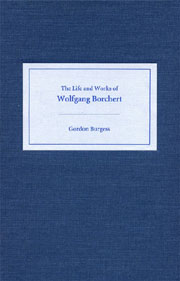Book contents
- Frontmatter
- Contents
- Acknowledgments
- List of Abbreviations
- Introduction
- 1 Childhood, School, Apprenticeship: 1921–1940
- 2 “The Happiest Time of My Life': January–June 1941
- 3 The Eastern Front and Courts-Martial: 1941–1943
- 4 Actor Turned Writer: Jena, Hamburg, and Basel: 1944–1947
- 5 The Poems
- 6 Draussen vor der Tür
- 7 The Short Stories
- 8 The Reception of Borchert's Life and Works
- Conclusion
- Published Works Cited
- Index
6 - Draussen vor der Tür
Published online by Cambridge University Press: 05 February 2013
- Frontmatter
- Contents
- Acknowledgments
- List of Abbreviations
- Introduction
- 1 Childhood, School, Apprenticeship: 1921–1940
- 2 “The Happiest Time of My Life': January–June 1941
- 3 The Eastern Front and Courts-Martial: 1941–1943
- 4 Actor Turned Writer: Jena, Hamburg, and Basel: 1944–1947
- 5 The Poems
- 6 Draussen vor der Tür
- 7 The Short Stories
- 8 The Reception of Borchert's Life and Works
- Conclusion
- Published Works Cited
- Index
Summary
AS NOTED EARLIER, neither Borchert's original manuscript of Draussen vor der Tür nor any of the copies immediately typed out by his father have survived. Three versions of the play exist, to all of which Borchert gave his seal of approval in some degree: the version as first published in 1947 and later incorporated into the Gesamtwerk; the first broadcast as a radio play; and the 1949 film version Liebe 47. The premiere in the Hamburg Kammerspiele, which Borchert is reported as having discussed with Wolfgang Liebeneiner and Hans Quest, follows the published version, with cuts similar to those made in the radio-play version. Since the published text can be regarded as representing Borchert's definitive position, we will examine this first, and then look at some of the ways in which the radio-play and film deviated from this version.
The Published Version
If the title Draussen vor der Tür indicates the theme of the outsider figure knocking at society's doors, the title originally proposed by Borchert, “Ein Mann kommt nach Deutschland,” more accurately reflects the subject matter. The central figure is Beckmann, an ex-soldier, returning to his native city of Hamburg, after the end of the Second World War — as one of the characters says, “der Krieg ist doch lange vorbei” (GW 131). Beckmann served in Siberia for three years, and has brought home what he ironically calls a souvenir, a gammy leg.
- Type
- Chapter
- Information
- The Life and Works of Wolfgang Borchert , pp. 151 - 173Publisher: Boydell & BrewerPrint publication year: 2003



